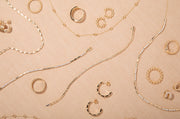It’s amazing to think about the journey of a natural diamond. These magnificent stones rose from way below the Earth's surface billions of years ago. Natural diamonds come from the depths of darkness and bring so much light and joy above ground.
Consider nature vs. nurture. Some things are naturally exquisite while others are made or constructed to be beautiful. This brings us to lab grown vs natural diamonds. It’s incredible - almost an art- to create a close replica of something that comes from nature. However, does it feel the same? Let’s explore the pros and cons of lab grown and natural diamonds to discover which one is the best choice for you.
What Are Lab Grown Diamonds
A lab grown diamond is a synthetic or man-made diamond that’s created in a lab. Lab grown diamonds actually have the same chemical, physical, optical and structural properties as natural diamonds. The most prominent difference between a natural and lab-grown diamond: a lab-grown diamond is created in a controlled environment over a relatively short amount of time while a natural diamond forms naturally, over a long period of time.
Other Diamond Simulants: Moissanite & Cubic Zirconia
When considering alternatives to real diamonds, there are also diamond simulants like moissanite and cubic zirconia. Both of these diamond simulants are popular due to their affordability and visual similarity to natural diamonds. Moissanite is a lab created diamond alternative with a unique chemical composition of silicon carbide, which gives a rainbow-like sparkle. Cubic zirconia, on the other hand, is a synthetic gemstone made from zirconium dioxide.
While lab created diamonds share the same pure carbon structure as their natural counterparts, diamond simulants like moissanite and cubic zirconia do not possess the same chemical composition and physical properties. These simulants are often used in custom jewelry designs, diamond engagement rings, diamond earrings, and other diamond jewelry pieces.
How Are Natural Diamonds Formed?
Natural diamonds were formed between one to three billion years ago in the Earth’s mantle. Carbon atoms, subjected to extremely high temperatures and pressure deep below the earth’s surface, naturally bonded together. The heat and pressure caused these carbon atoms to form crystalline lattice structures which resulted in a rough diamond.
Diamonds remained hidden deep within the Earth for hundreds of millions of years, until volcanic activity violently propelled them upwards towards the surface. Vertical rock formations, called “kimberlite pipes,” are remnants of these ancient volcanoes.
Benefits of Choosing Natural Diamonds
- Natural diamonds have shown that, over time, they can maintain and even grow in value.
- Some people appreciate things that come from nature more than something that was created in a lab. Natural diamonds are one of the most gorgeous things to come from the earth. They're a natural wonder with history and age. Therefore, they seem to possess a “power” that contributes to their beauty.
- While there is no guarantee that price will rise, it has been proven that natural diamonds retain most of their value subject to market fluctuations both upwards and downwards.
- While lab grown diamonds are fairly new, it is clear that they have no long term value. With more and more lab grown diamonds being produced, the price of lab grown diamonds has continued to fall year over year.
Cost Comparison
- Lab grown diamonds can cost up to 90% less than their natural diamond counterparts.
- This is the result of basic economic supply/demand principles as there is no supply constraint on the production of lab-grown diamonds.
- Natural diamonds - while significantly more expensive - hold their value.
- A natural diamond’s value can sometimes increase depending on the particular diamond’s characteristics — cut, rarity, etc..
Appearance Comparisons
Natural and Lab Grown diamonds optically look the same. Amazingly, they both respond to light in a very similar way and exhibit the same structural hardness.
Durability and Care
Natural and lab grown diamonds exhibit the same structural hardness and conductivity of heat. Therefore, durability and care for a natural and a lab made diamond is the same.
Making the Right Choice for You
DRD wants customers to have a diamond that will have value in the long run. At the very least, a high quality, natural diamond will hold its value. There will be unpredictable ups and downs with natural diamond prices but history has shown that natural diamonds do hold their value over the years.
While lab grown diamonds look great, perform like diamonds and are extremely inexpensive, it is clear that they have almost zero intrinsic value.
As with any high-impact purchase, it’s important to consider all of the possibilities. We live in a world full of illusions, where almost anything can be made to “appear real.” This is both amazing and devastating, depending on the situation. There is a neutrality toward lab grown diamonds (in our opinion, of course). Based on the appearance comparison (above), a lab grown diamond will look the same as a natural diamond. Many people rock lab grown diamonds until they have enough to spend on a natural diamond. No judgment, for real, fortunately, we live in a world with these types of choices! Your diamond is out there! The DRD team of GIA certified specialists are always available to answer any questions and walk you through options in order to make the best choice!





